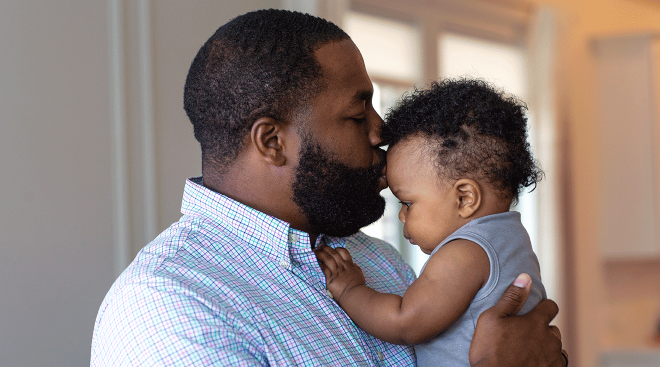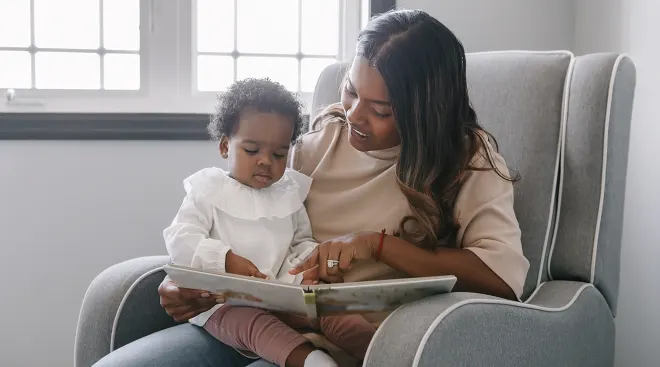How to Normalize All Family Structures for Young Kids
Anyone who has seen toddlers sort Magna-Tiles by shape and color knows that little kids like compartmentalization. They’re naturally inclined to identify and categorize the things they see. Of course, while squares are squares and circles and circles (easy-peasy!), families aren’t nearly as simple to define and put in a bucket.
The first group that a child comes into contact with is their own family—and this familial structure sets the foundation for what they think is the norm. “Toddlers are not yet picking up on what other families are like, they are only picking up on their families,” says Melanie Killen, PhD, a professor and the director of the Social Moral Development Lab at the University of Maryland. “A child with two mothers has two mothers and doesn’t know otherwise.” Once they start preschool, around 3 years of age, they start seeing these distinctions and will realize that some families are different from their own.
The reality is that families no longer fit that bygone, cookie-cutter formula: Mom and me, plus Daddy makes three—typically of the same race and religion. In the 1960s, about 88 percent of kids lived with two parents, 8 percent lived with only their mom and just 1 percent lived with their dad, according 2018 study findings. By 2016, 69 percent of children were living with two parents, 23 percent were in households with just a mom and 4 percent were with their dad only. What’s more, by 2019, 15 percent of same-sex couples in the United States had at least one child, according to the US Census Bureau. Suffice to say, the idea of the traditional family makeup has evolved, and it’s not uncommon for children to live with or meet families with more fluid structures: unmarried and cohabitating parents, single parents, interracial and multicultural parents, same-sex parents and co-residence with grandparents.
Still, conceptualizing different family structures is challenging for a young mind, especially when the imagined version of what a family looks like doesn’t always align with what they see in their own environment, in books and on television.
Of course, it’s no surprise that you have a big impact on what your child thinks and values. Parents convey explicit and implicit messages, and preschoolers pick up on what’s normative and what’s not, Killen says. Young children’s belief systems are still malleable, meaning you can and should help expand their horizons. “These seeds are planted early on,” says Saba Harouni Lurie, LMFT, founder of Take Root Therapy. “It guides what they’ll be open to in the future. The more we can introduce and expose children to different ideas of families, the more we are planting those seeds.”
Want to help your child along this inclusive path? Below, a few tips to foster an understanding and acceptance of diversity in family structures.
It’s easy to default to books, media and toys that illustrate what you already have. But storytelling that mimics your own family short-circuits growth. Yes, choosing a character that your child can relate to is great, but doing that exclusively can cement a sort of linear thinking.
Encourage children to peek into other worlds. “Get books [and watch shows] about different family structures,” Killen recommends. “Those groups are in the minority, so it’s even more of a responsibility for the majority to expose their kids to family diversity.” The toddler-friendly Love Makes A Family, by Sophie Beer, is a colorful board book that illustrates daily tasks from breakfast to bedtime through a myriad of families—single parents, two dads or mom and dad. Older children can delve into Eyes that Kiss in the Corners by Joanna Ho. The story stars a young Taiwanese girl who finds confidence in her uniqueness through exploring her culture with three generations of women in her household.
Toddlers are curious creatures and tell it like it is. Parents, on the other hand, tend to shirk in embarrassment, often shushing kids’ questions (as in, “Why are those mommies holding hands?”). The “we’ll talk at home” response sends a message that something is wrong with the situation, Killen points out. Instead of worrying that you’re somehow uncouth in answering your child’s question directly, embrace the situation in a positive way. Highlight that it’s a good observation, inviting conversation. You can say, “Those moms are holding hands because they love each other, just like me and daddy.” Hearing this validation emphasizes the acceptance of a different type of family. “Make it real for kids, to show that this exists in the actual universe,” says Kristi Beroldi, LPC, an assistant clinic director at Thriveworks, who has a 10-month-old girl with her wife. “If I overheard this, I’d think it’s so nice that this family is accepting of us.”
As a parent, you may feel the weight of teaching morality and acceptance; sometimes what is well-meaning comes across as a forced agenda, though. “It doesn’t have to be a lesson,” says Killen, who encourages parents to approach any talk of diversity through routine communication and open-ended questions. Break down conversations about diversity into bite-size pieces; chances are, you’ll have the same conversation 10 times over. “Gauge how engaged your kids are,” Harouni Lurie adds. “You’ll see when they check out of the conversation.” Much like you wouldn’t serve a whole cake to your toddler, dole out discussions about diversity in family structure one slice at a time. Don’t force the topic; rather, let it happen naturally.
Young children can understand things even if they can’t carry on an in-depth conversation, Killen says. One way to introduce different family structures is to draw a forest of family trees. Start with your own, and then add trees representing diverse family makeups and let them ask questions. If your child asks if two dads living together are brothers, explain that some men love men and some women love women, but what really matters is that they are loving parents. Little kids care less about the importance of diversity in society than they do about getting an answer. “Keep it simple,” emphasizes Beroldi. These early explanations will serve as the foundation for future, more complex conversation.
Toddlers are just starting to form their values, so how you communicate acceptance is crucial. Respect is at the core. “If we can normalize and celebrate differences, it allows children to develop a relationship with people who aren’t like them, making space for other ways of being in the world,” Harouni Lurie says. You can do this in many ways. For example, honor a holiday you normally don’t celebrate: Try baking hamantaschen cookies for the Jewish holiday Purim or tie-dying for Holi, the Hindu Festival of Color. Simply put, lead by example. Show respect and give open acceptance to families that are different from your own—culturally and structurally—and your child will too.
Unless you’re closely connected to a family that’s significantly different in structure, it’s hard to truly know how these differences play out in someone’s day to day lives; they may face certain challenges and stereotypes you’re not aware of. To that end, realize that you’re not necessarily an expert. As a parent, you may feel the pressure to answer your kids’ questions right away, but impulsive answers aren’t always accurate. There’s nothing wrong with replying, “Let me think about that and get back to you.” Then be sure to follow up on your promise. Parents don’t always take the role of an investigator, and that’s really important, Killen says. Show that you have an open mind and a desire to learn more about other families and family structures, and your kids will follow suit.
About the experts:
Kristi Beroldi, LPC, is a mental health counselor in Virginia. Beroldi works with clients on a variety of issues, including depression, anxiety, life transitions and self-esteem with a focus on children and adolescents.
Saba Harouni Lurie, LMFT, ATR-BC, is a licensed marriage and family therapist and board-certified art therapist. She is the owner and founder of Take Root Therapy, a group psychotherapy practice in Los Angeles, California.
Melanie Killen, PhD, is a professor of human development and quantitative methodology at the University of Maryland. She earned her PhD in developmental psychology at the University of California, Berkeley, in 1985.
Plus, more from The Bump:
Navigate forward to interact with the calendar and select a date. Press the question mark key to get the keyboard shortcuts for changing dates.




















































